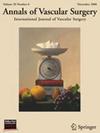腋窝静脉与颈静脉在全植入a型静脉导管中的对照试验
IF 1.4
4区 医学
Q3 PERIPHERAL VASCULAR DISEASE
引用次数: 0
摘要
背景:比较颈内静脉与腋窝静脉在肿瘤患者全身静脉治疗中进行PORT -a-cath (PORT -a-cath)植入术的安全性和有效性。该研究在巴西圣保罗的AC Camargo癌症中心进行。在2017年4月至2021年6月期间,总共招募了240名患者,其中213名患者被纳入研究的最终分析。参与者被随机分配到腋窝或颈静脉通路组。在超声和x线镜引导下,促进PORT放置。该研究的主要目的是评估总并发症发生率,并根据意向治疗和方案原则对其进行分析。结果两种接入点的并发症发生率均较低,差异无统计学意义。但腋窝组血栓形成倾向较高,导致4例患者行PORT切除。结论虽然腋静脉入路具有一定的优势,如切口单一,无需皮下隧道,但我们的研究结果表明,颈内静脉入路往往是更实用的选择,因为它的直径更大,位置更浅,并且右颈内静脉直入右心房。因此,尽管腋静脉是可行的选择,但颈内静脉可能是更合适的选择,特别是对于血栓形成风险较高的患者。本文章由计算机程序翻译,如有差异,请以英文原文为准。
Axillary versus Jugular Vein for Totally Implanted Port-A-Cath, Randomized, Controlled Trial
Background
To compare the safety and efficacy of the internal jugular vein and the axillary vein access points for port-a-cath (PORT) implantation in cancer patients undergoing systemic intravenous treatments.
Methods
The study was conducted at the AC Camargo Cancer Center in São Paulo, Brazil. Between April 2017 and June 2021, a total of 240 patients were initially recruited, of whom 213 were included in the final analysis of the study. Participants were randomly assigned to either the axillary or jugular access groups. The PORT placement was facilitated using ultrasound and radioscopy guidance. The study's primary objective was to assess the total complication rate, which was analyzed following both intention-to-treat and per-protocol principles.
Results
The overall complication rates for both access points were low and not significantly different. However, there was a higher tendency toward thrombosis in the axillary group, leading to the PORT removal in 4 patients.
Conclusion
Although axillary vein access offers certain advantages, such as a single incision and elimination of the need for a subcutaneous tunnel, our findings suggest that internal jugular vein access may often be a more practical choice due to its larger diameter, superficial location, and straight trajectory to the right atrium for the right jugular. Therefore, despite axillary vein access serving as a viable alternative, internal jugular vein access might be a more suitable choice, especially for patients at a higher risk of thrombosis.
求助全文
通过发布文献求助,成功后即可免费获取论文全文。
去求助
来源期刊
CiteScore
3.00
自引率
13.30%
发文量
603
审稿时长
50 days
期刊介绍:
Annals of Vascular Surgery, published eight times a year, invites original manuscripts reporting clinical and experimental work in vascular surgery for peer review. Articles may be submitted for the following sections of the journal:
Clinical Research (reports of clinical series, new drug or medical device trials)
Basic Science Research (new investigations, experimental work)
Case Reports (reports on a limited series of patients)
General Reviews (scholarly review of the existing literature on a relevant topic)
Developments in Endovascular and Endoscopic Surgery
Selected Techniques (technical maneuvers)
Historical Notes (interesting vignettes from the early days of vascular surgery)
Editorials/Correspondence

 求助内容:
求助内容: 应助结果提醒方式:
应助结果提醒方式:


